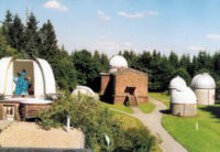Institutes
Last update: March 8, 2023
The Zentrum für Astronomie der Universität Heidelberg (ZAH) was established in 2005 by joining the Astronomisches Rechen-Institut (ARI), the Landessternwarte Königstuhl (LSW) and the Institut für Theoretische Astrophysik (ITA).
Astronomisches Rechen-Institut (ARI)
Mönchhofstr. 12-14
69120 Heidelberg
Tel: 06221 54 1801
Email: egrauer(at)ari.uni-heidelberg.de
Professors:
Prof. Dr. Eva K. Grebel
Prof. Dr. Björn Malte Schäfer
Prof. Dr. Joachim Wambsganss
Prof. Dr. Dominika Wylezalek
The Astronomisches Rechen-Institut (ARI) was founded in 1700 in Berlin and moved to Heidelberg after World War II. Its main research areas are extrasolar planets, stellar dynamics, star clusters, galaxy evolution, galaxy clusters, gravitational lensing, and cosmology. ARI astronomers use a wide range of ground-based and space-based optical, infrared, and X-ray observatories as well as high-performance supercomputers. ARI has published a long series of fundamental astronomical catalogs and leads the German Astrophysical Virtual Observatory (GAVO). ARI also hosts several DPAC Workpackages of the Gaia mission of the European Space Agency (ESA). ARI is also involved in several other international projects (including LSST, RAVE, Pan-STARRS, LAMOST, GREAT, LEGUS, HTTP, 4MOST, and microlensing networks).
Institut für Theoretische Astrophysik (ITA)
Albert-Ueberle-Str. 2
69120 Heidelberg
Tel. (AU-2): 06221 54 4837
Email: ita-verwaltung(at)zah.uni-heidelberg.de
Professors:
Prof. Dr. Cornelis P. Dullemond
Prof. Dr. Michela Mapelli
Prof. Dr. Ralf S. Klessen
Prof. Dr. Fritz Röpke (HITS/ZAH)
The Institut für Theoretische Astrophysik (ITA) of the University of Heidelberg was established in 1976. Scientists at ITA investigate a wide range of astrophysical processes and objects theoretically and numerically. Research topics range from the formation of stars and planets, stellar astrophysics and stellar explosions, to astrochemistry and the dynamics of the interstellar medium, computational hydrodynamics and radiation transport, gravitational waves and cosmology. ITA is involved in several national and European research consortia, the DFG Priority Programme 1992 "Diversity of Exoplanets", the DFG Research Unit 2634 "Planet Formation Witnesses and Probes: Transition Discs", the STRUCTURES Cluster of Excellence, or the ERC-Synergy funded project ECOGAL. In addition, ITA participates in a number of observational survey projects such as ALMAGAL, LVM, SIGNALS or THOR.
Landessternwarte Königstuhl (LSW)
Königstuhl 12
69117 Heidelberg
Tel.: 06221 54 1700
Email: d.mueller-wolkenstein(at)lsw.uni-heidelberg.de
Professors:
Prof. Dr. Andreas Quirrenbach
Prof. Dr. Norbert Christlieb
Prof. Dr. ir. Saskia Hekker (HITS/ZAH)
The observatory at Königstuhl was inaugurated on 20th June 1898 by the grand duke Friedrich I. of Baden. The contemporary Landessternwarte Königstuhl (LSW) is active in the fields of stellar and extragalactic astrophysics. The institute is also involved in the development and building of the Lucifer-spectrograph for the near infrared at the Large Binocular Telescope or the 4MOST instrument to be attached to ESO's VISTA telecope on Paranal. In the domain of high-energy astrophysics the LSW participates in the H.E.S.S.-teleskope in Namibia. Special emphasis is taken on active galaxies and quasars also supported by optical observations and theoretical work. Another working group on stellar physics is engaged in hot stars and compact objects. The technique of interferometry is developed for ESO telscopes (VLTI) and used especially for the search of extra-solar planets.



